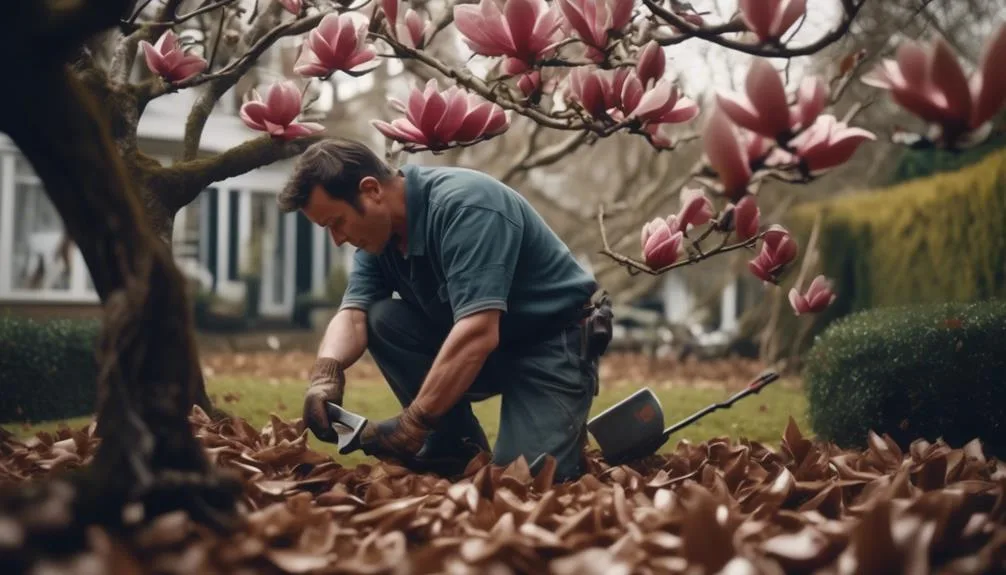Caring for a magnolia tree may seem easy, but it actually requires a lot of work. Regular pruning, fertilizing, and dealing with pests and diseases are all part of keeping a magnolia tree healthy.
The effort pays off, though, as a well-cared-for magnolia tree adds stunning beauty to any garden with its iconic blossoms.
But just how much work does it involve, and what exactly do you need to do? Let's take a closer look at magnolia tree care to find out.
Pruning and Trimming
When caring for your magnolia tree, it's essential to regularly prune and trim to maintain its health and shape. Seasonal pruning is crucial for promoting new growth and maintaining an attractive form.
Start by removing any dead or damaged branches in the late winter or early spring to encourage healthy regrowth. Additionally, shaping techniques can be employed to control the size and silhouette of your magnolia tree. By selectively pruning certain branches, you can guide the tree's growth and enhance its natural beauty.
Be sure to use sharp, clean tools and make precise cuts to minimize stress on the tree. Proper pruning and shaping techniques won't only improve the overall appearance of your magnolia tree but also contribute to its long-term health and vitality.
Fertilizing and Soil Care
To ensure the optimal health and growth of your magnolia tree, it is essential to provide proper fertilization and soil care. Nutrient deficiencies can hinder the tree's development, so amending the soil with the right fertilizers is crucial. Consider the table below for a quick comparison of organic and synthetic fertilizers:
| Aspect | Organic Fertilizers | Synthetic Fertilizers |
|---|---|---|
| Nutrient Release | Slow release, gradual nutrient availability | Quick release, rapid nutrient availability |
| Soil Health | Improve soil structure and microbial activity | Minimal impact on soil health |
| Environmental Impact | Low risk of leaching or groundwater pollution | Higher risk of leaching and pollution |
When selecting the right fertilizer for your magnolia tree, consider its specific needs and your environmental concerns. Regular soil testing can help identify any deficiencies and guide your fertilizer choice.
Pest and Disease Management
Managing pests and diseases is crucial for preserving the health and vitality of your magnolia tree. To ensure the well-being of your tree, consider the following strategies:
- Integrated Pest Management (IPM)
- Implement cultural practices such as proper pruning and sanitation to minimize pest infestations.
- Introduce beneficial insects or organisms to control harmful pests, reducing the need for chemical treatments.
When addressing disease control, it's important to explore both natural remedies and chemical treatments:
- Disease Control
- Utilize natural remedies like neem oil or horticultural oils to combat common diseases.
- If necessary, consider targeted chemical treatments to effectively manage severe disease outbreaks.
Watering and Mulching
Proper watering and mulching are essential for maintaining the health and vigor of your magnolia tree. When it comes to watering, it's crucial to ensure that your magnolia receives consistent moisture, especially during dry periods. However, overwatering can lead to root rot, so it's important to find the right balance. Mulching offers several benefits, including moisture retention, weed suppression, and protection from temperature fluctuations. Here's a quick overview of proper watering and mulching benefits:
| Proper Watering | Mulching Benefits |
|---|---|
| – Deep watering | – Retains moisture |
| – Avoiding overwatering | – Suppresses weeds |
| – Consistent moisture | – Protects from temperature fluctuations |
| – Especially during dry periods | – Enhances soil fertility |
Overall Maintenance
Maintaining the health and vigor of your magnolia tree involves more than just watering and mulching. Overall maintenance also plays a crucial role in ensuring its long-term well-being. Proper seasonal care is essential for the optimal growth of your magnolia tree.
Pruning in late winter or early spring helps shape the tree and promotes healthy growth. Regularly inspect for pests and diseases, especially during the growing season, to address any issues promptly.
Additionally, understanding the growth habits of your specific magnolia tree species is vital for providing appropriate care. Some magnolias are fast-growing and may require more frequent maintenance, while others have slower growth rates and need less attention.
Conclusion
In nurturing a magnolia tree, the labor-intensive care pays off with its breathtaking beauty and aromatic blooms.
Regular maintenance through pruning, fertilizing, and pest control, along with consistent watering and mulching, ensures the tree's enduring health and vibrancy.
With devoted attention, the magnolia tree will stand as a captivating centerpiece in your garden for years to come, a testament to the rewards of dedicated care and attention to nature.

My interest in trees started when I first saw the giant sequoias in Yosemite.
I was a teenager then, and I remember thinking, “I need to learn more about this.”
That moment stuck with me.
A few years later, I went on to study forestry at Michigan Tech.
Since graduating, I’ve worked in a mix of hands-on tree care and community education.
I’ve spent over ten years helping people understand how to plant, maintain, and protect the trees in their neighborhoods.
I don’t see trees as just part of the landscape.
They are living things that make a real difference in our daily lives.
